Poinsettia Health: Video #12
We’re back at it with another video in our series intended to help you produce your best crop ever. This one is short but sweet, just a few minutes long, but packed with information critical to you and your production team. Video #12 is all about WATER QUALITY AND FERTILITY.
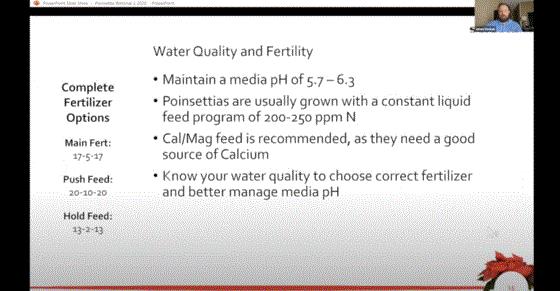
The guests from Selecta One give specific recommendations for media pH, what fertilizer works best, the optimum methods for feeding, and what your poinsettia crop needs at this stage in the game. They remind all growers to know your water quality and test often in order to make the best decisions as your crop progresses.
And … Another Poinsettia Video
Since the last one was pretty short, why not serve up two helpings of poinsettia production knowledge this week? They pretty much go hand in hand.
Video #13 is on MEDIA QUALITY, PH AND EC. It focuses on media fertility and the importance of regular testing, adding to the information in the previous video.
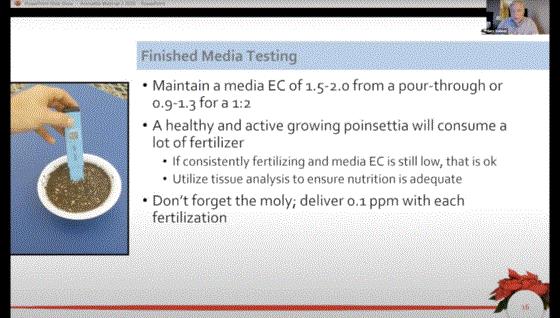
The speakers remind you to get comfortable with regular testing, and how to interpret the results to develop a solid fertilization plan. Actively-growing poinsettias are heavy feeders and you need to be ready to give them what they need, when they need it. You’ll learn tips and tricks to bring the crop along in a healthy way, as well as what to supply and why. They finish the video with a look at charts of finished media pH and EC to help you use the data effectively.
It's part of our IN THE BREAK ROOM: POINSETTIA SERIES (organized conveniently into one handy YouTube playlist!)
Nick’s Tip of the Week: Foliar Leaf Spotting on Pansies
Each week, I’ll work with my partner in crime Nick Flax, a technical services expert at Ball, to share a concern that’s come up during one of his numerous calls with growers across North America. This week he’s addressing pansy leaf spots.
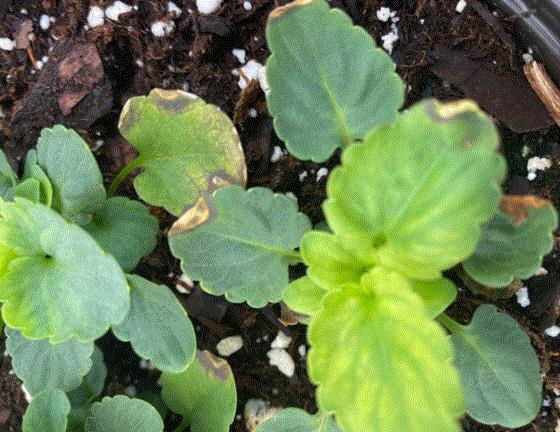
PROBLEM: While everyone has been battling mum and early-season poinsettia challenges, another problem typical of this time of year has cropped up. This week, several growers reached out for help with mysterious leaf spots appearing on their fall pansies.
NICK’S TIP: A few factors can cause leaf spots on pansies, so how do you know what is causing the problem and how to treat for it? Let’s dive in and break this pansy leaf spotting issue down into two categories: 1) abiotic, and 2) biotic. Let me address both, one at a time.
Abiotic Leaf Spotting: For those of you who aren’t familiar with growing pansies, know that this is a low-pH-loving crop (optimal pH range is 5.5–6.0). Lots of growers use “pansy feed” fertilizer formulations, which are more acidic and drive the growing media pH down slowly over time; or alternate feeding with general-use, ammonia-based fertilizers to help keep pH low.
However, if fertilizer is mismanaged and the soil pH gets too low, dark spots will start to appear on leaves—this is iron (Fe) and manganese (Mn) toxicity. If low pH is not corrected promptly, leaves will become severely discolored and necrosis will begin swallowing up affected leaves. Heavily affected leaves typically do not recover, so be sure to take the following measures to prevent this issue:
-
Know your water quality. Get your water tested regularly and build your fertilizer program around the needs of your crops and limitation created by your water quality.
-
Get in front of the problem. Monitor soil pH regularly and switch to a different fertilizer (acidic or basic) if soil pH begins drifting away from optimum.
-
Act quickly if pH crashes. If raising pH with a nitrate-based fertilizer is not enough, don’t wait to see what happens, and apply a liming agent of some kind (CalOx is great).
Biotic Leaf Spotting: Pansies are affected by a variety of diseases, but in this week’s tip we’re just focusing on foliar leaf spot diseases: Colletotrichum (anthracnose) and Cercospora. These pathogens favor moderate to cool temperatures and free moisture on leaves, so cooler nights and rain in the late afternoon/evening is a perfect recipe for an outbreak.
However, a common factor leading to disease that is often overlooked is low nutrition, so be sure to check your soil EC (soluble salt levels) when you are monitoring soil pH. Maintaining soil EC around 1.5 mS/cm (via Pour-Thru method for testing) and below 2.0 mS/cm will ensure your crops are receiving adequate (but not too much) fertilizer and reduce susceptibility to foliar leaf spot diseases. Below are a few key ID traits for these leaf spot diseases and how to manage them if an outbreak occurs:
-
Colletotrichum. Starts as small grayish/tan spots with black margins under warm, moist conditions. Spots often develop a concentric ring pattern, which can be confused with a viral disease. Lesions grow to infect stems and eventually cause the plant to collapse. Remove heavily infected plants and fallen debris to reduce spread and apply fungicide with mancozeb or thiophanate-methyl + mancozeb ASAP when symptoms first appear.
-
Cercospora. Purple spots with “fuzzy” margins typically start on lower leaves. If untreated, small purple spots will begin appearing on upper leaves, and older lesions will expand into irregularly shaped tan spots with purple borders. Heavy infection will cause lower leaf chlorosis followed by leaf drop and overall stunting. Remove infected plants and debris ASAP and treat with fungicide. Mancozeb + thiophanate-methyl, myclobutanil, fludioxonil, and chlorothalonil are all effective to control this pathogen.

UF Digital Education
In late May, University of Florida kicked off another online course in greenhouse production and management. Up to this point, the curriculum has focused on management and profitability, but they’ll soon transition to hardcore cultural and technical topics like disease and weed management. You can sign up for the entire course (or specific modules) in English or Spanish HERE. This would be a fantastic training opportunity for your newer production team members.
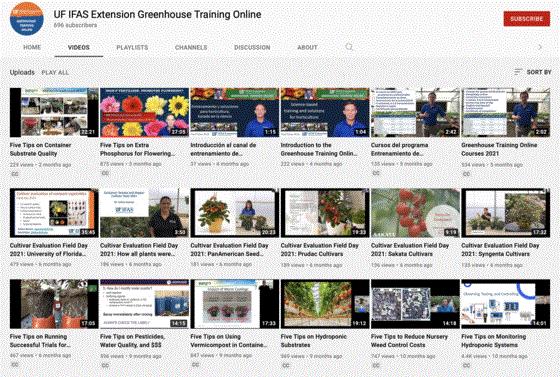
Beyond the course content, UF has released some shorter videos on their YOUTUBE CHANNEL that cover specific topics like container substrates, pesticides and water quality. The videos also include important discussions on lighting, hydroponics, best practices and many more. It is truly a treasure trove of bilingual digital education, no matter your skill level.
Preparing for Greenhouse Trials
With margins getting narrower and the tolerance for inefficiency and shrink dropping to near zero, trialing and testing new genetics before replacing existing varieties is more important than ever.
Do you conduct greenhouse trials? You probably do, but is your process strategic or do you find yourself planting up trials and then losing track of them as the season ramps up? I can’t tell you how many times I’ve been in a greenhouse and asked to check out the new variety trials and been met with a blank stare or chuckle as my host reminds me it’s busy season and they have absolutely no idea where the trial material disappeared to. Don’t worry, you’re not the only one in this boat.

Nonetheless, trialing is important for the reasons stated above. A couple years ago, I recorded a podcast on this exact topic with Jason Twaddell, formerly sales manager of Ball FloraPlant and currently a Ball Seed sales rep in the Midwest. Some of the topics he covers include trialing to solve problems and not just to evaluate what’s new, improving labor–intensive processes, and the importance of an internal champion to maximize resources. Jason details the steps to take when implementing an effective trial strategy and also how to plan and prioritize to achieve the goals you set.
CREATING YOUR TRIAL PLAN is appropriate for many roles in your greenhouse operation, from management to section growers. Getting your team aligned when putting trials in place is critical to the whole process.

Quick Tech Tip: Poinsettia Collapse
I hope you never see symptoms like this, but if you do, here are some ideas to set you on the path to recovery.
Note the collapse below the red area on the stem. The collapse of the stem shows either disease infection or fungus gnat larvae feeding.
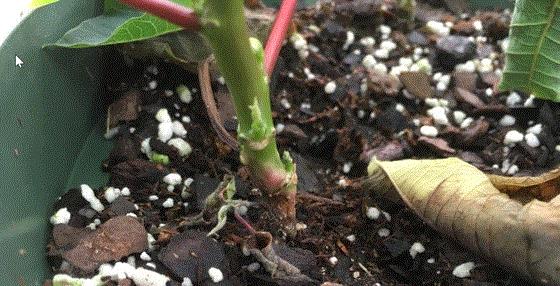
What to do? Check the root system. If roots look normal, then check for Rhizoctonia. If the roots are collapsed, then check for Pythium. If there are larvae feeding, look for holes in the stem where the larvae entered the stem.
Finish Line …
I like to check in every few weeks to let you know we have a lot in the works at Tech On Demand and to ask if there’s anything you need. Now is that time.
We’re in the process of creating 52 weeks of content, covering specific crops, general at-risk information, disease and insect control strategies, and production best practices. We’ll roll these modules out at the appropriate time, ahead of when you’ll need to implement the processes.
Thanks to some magical data analysis that’s beyond my editorial pay grade, we know when your plant orders will ship and can use this information to get ahead of the game. Our goal is to provide the technical info you need early enough that you can develop plans accordingly. Watch for it ... and if I may be so bold as to ask, please mention this newsletter to your peers so they, too, can be in the know.
The second part of this equation is you, dear reader, providing feedback and suggesting the topics that would be most beneficial to you and your team. Let me know what we can do for you! Get in touch any time. I’m at your disposal. Customer is king.



As always, my email is bcalkins@ballhort.com if you have any comments, suggestions or challenges we can help solve.

Bill Calkins
Editor - Tech On Demand
This email was received by you and 25,335 other fine subscribers!
If you're interested in advertising in Tech On Demand, contact Kim Brown ASAP and she'll hook you up.